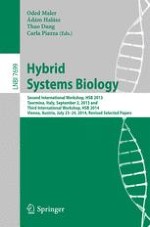This book constitutes the thoroughly refereed post-workshop proceedings of the Second International Workshop on Hybrid Systems Biology, HSB 2013, held as part of the ECAL 2013 event, in Taormina, Italy, in September 2013; and the Third International Workshop on Hybrid Systems Biology, HSB 2014, held as part of CAV 2014, in Vienna, Austria, in July 2014.
This volume presents 8 full papers together with 2 invited tutorials/surveys from 21 submissions.
The HSB 2013 workshop aims at collecting scientists working in the area of hybrid modeling applied to systems biology, in order to discuss about current achieved goals, current challenges and future possible developments.
The scope of the HSB 2014 workshop is the general area of dynamical models in biology with an emphasis on hybrid approaches, which are not restricted to a narrow class of mathematical models, and which take advantage of techniques developed separately in different sub-fields.
<
